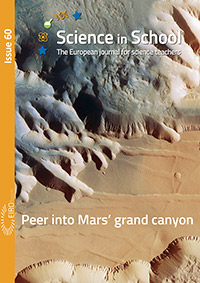Colour in nature: true blue
Have you ever seen a blue cow? A blue apple? Or a blue tree? Blue is rare in nature, so why are some plants and animals blue?

Showing 10 results from a total of 43
Have you ever seen a blue cow? A blue apple? Or a blue tree? Blue is rare in nature, so why are some plants and animals blue?
In a spin: use a rotating platform to explore how gravitational acceleration affects a simple pendulum.
Enhance your students’ knowledge of electrolysis using quick, safe, and easy microscale chemistry techniques.
Set the wheels in motion: maximize your creativity by using old bicycle parts to create art installations and demonstrate energy conversions.
Seeing science in a new light: build your own stroboscope and use it to create beautiful optical illusions with water!
Help students develop STEAM skills by building a smart lamp with this creative project that combines physics, programming, and art and design.
Recent images from ESA's Mars Express mission show two ruptures in the martian crust that form part of a mighty canyon system.
Why was a Nobel prize awarded for 'click chemistry'? Learn about the ground-breaking advance behind this simple-sounding name.
Learn how fluorescence microscopy can illuminate our gut microbiome and its role in cancer.
Colour in nature: true blue

The centrifugal force awakens
Elegant electrolysis – the microscale way
From cycling to upcycling: learn about energy conversions by building creative installations from old bicycles
‘Defying’ gravity with a simple stroboscope
Design and build a smart lamp
Mars Express peers into Mars’ ‘Grand Canyon’
Click does the trick: understanding the 2022 Nobel Prize in Chemistry
Shedding light on the gut microbiome